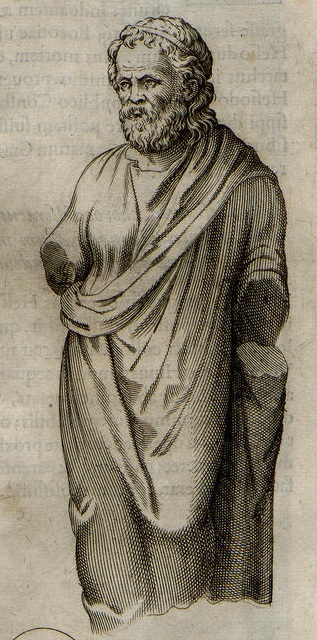Orsini Homer: Difference between revisions
Nick White (talk | contribs) No edit summary |
(Misc updates from William) |
||
| Line 3: | Line 3: | ||
[[File:Orsini Homer.jpg|right]] | [[File:Orsini Homer.jpg|right]] | ||
'''Image''': Extract from | '''Image''': Extract from Orsini, F. 1570. ''Imagines et Elogia...'' Rome. p. 21. | ||
'''Object Description''': A | '''Object Description''': A statuette of Homer known to Fulvio Orsini in the mid-sixteenth century. | ||
'''Discussion''': | '''Discussion''': Faber, in his compilation of Orsini’s notes, describes this object as an ‘imaguncula marmorea’ (a marble portraitling) (Faber 1606: 45). From this we know that the illustrated object is a marble statuette of the poet. The support (a common feature of sculpture in stone) beneath the left elbow further indication of the object’s material. The statue is broken off beneath the knees, and lacks both arms below the elbow. The figure wears a fillet (which suggests a poetic role), and apparently a ''chiton'' (tunic) and ''himation'' (cloak). This image has been thought to resemble the ''Apollonius of Tyana Type Homer'', and is used as a criterion for its identification. | ||
== Bibliography == | == Bibliography == | ||
<div id="bibliography"> | <div id="bibliography"> | ||
* Cellini, G. A. 2004. ''Il Contributo di Fulvio Orsini alla Ricerca Antiquaria.'' Rome. | * Cellini, G. A. 2004. ''Il Contributo di Fulvio Orsini alla Ricerca Antiquaria.'' Rome pp. 352-357. | ||
* Faber, J. 1606. ''In Imagines Illustrium… Commentarius.'' Antwerp. p. 45, n. 72. | |||
* Kätzlmeier-Frank, M. 1993. Theodor Galles Zeichnungen zu Fulvio Orsinis Imagines : der Codex Capponianus 228. Münster. | * Kätzlmeier-Frank, M. 1993. Theodor Galles Zeichnungen zu Fulvio Orsinis Imagines : der Codex Capponianus 228. Münster. | ||
* Richter, G. M. A. 1965. ''The Portraits of the Greeks I'' (vol. 1). London. pp. 48-50. | * Richter, G. M. A. 1965. ''The Portraits of the Greeks I'' (vol. 1). London. pp. 48-50. | ||
* Richter, G. M. A. and Smith, R. R. R. 1984. ''The Portraits of the Greeks.'' London. p. 144 | * Richter, G. M. A. and Smith, R. R. R. 1984. ''The Portraits of the Greeks.'' London. p. 144. | ||
* Orsini, F. ''Imagines et Elogia.'' Rome. pp. 20-21. | |||
</div> | </div> | ||
Revision as of 15:41, 25 February 2014
Image: Extract from Orsini, F. 1570. Imagines et Elogia... Rome. p. 21.
Object Description: A statuette of Homer known to Fulvio Orsini in the mid-sixteenth century.
Discussion: Faber, in his compilation of Orsini’s notes, describes this object as an ‘imaguncula marmorea’ (a marble portraitling) (Faber 1606: 45). From this we know that the illustrated object is a marble statuette of the poet. The support (a common feature of sculpture in stone) beneath the left elbow further indication of the object’s material. The statue is broken off beneath the knees, and lacks both arms below the elbow. The figure wears a fillet (which suggests a poetic role), and apparently a chiton (tunic) and himation (cloak). This image has been thought to resemble the Apollonius of Tyana Type Homer, and is used as a criterion for its identification.
Bibliography
- Cellini, G. A. 2004. Il Contributo di Fulvio Orsini alla Ricerca Antiquaria. Rome pp. 352-357.
- Faber, J. 1606. In Imagines Illustrium… Commentarius. Antwerp. p. 45, n. 72.
- Kätzlmeier-Frank, M. 1993. Theodor Galles Zeichnungen zu Fulvio Orsinis Imagines : der Codex Capponianus 228. Münster.
- Richter, G. M. A. 1965. The Portraits of the Greeks I (vol. 1). London. pp. 48-50.
- Richter, G. M. A. and Smith, R. R. R. 1984. The Portraits of the Greeks. London. p. 144.
- Orsini, F. Imagines et Elogia. Rome. pp. 20-21.
| Relevant guides | Homer: A Guide to Sculptural Types |
|---|

